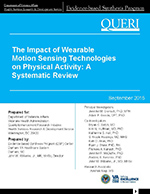
Principal Investigators: Jennifer M. Gierisch, PhD, MPH; Adam P. Goode, DPT, PhD Co-Investigators: Bryan C. Batch, MD; Kim N, Huffman, MD, PhD; Katherine S. Hall, PhD; S. Nicole Hastings, MD, MHS; Kelli D. Allen, PhD; Ryan J. Shaw, PhD, RN; Frances A. Kanach, PhD; Jennifer R. McDuffie, PhD; Andrzej S. Kosinski, PhD; John W. Williams, Jr., MD, MHSc; Research Associate: Avishek Nagi, MS
Download PDF: Complete Report, Abstract, Report, Appendices
Participation in regular physical activity is important for improving health, but sedentary behavior is difficult to change. One option is to provide feedback on physical activity with wearable motion sensing technologies (activity devices). This review sets out to synthesize the literature on the effectiveness of these devices for physical activity, weight, and patient satisfaction outcomes, and to describe moderating factors that may impact effectiveness (ie, population characteristics, location where device is worn on body, or device role in overall intervention approach).
Key Question 1: Among adults, what is the effectiveness of wearable motion sensing technologies on: (a) physical activity levels; (b) weight loss or maintenance; (c) patient satisfaction with healthcare?
Key Question 2: Among adults, does the impact of wearable motion sensing technologies vary by: (a) characteristics of the population; (b) type of adjunctive interventions; (c) adherence to use of the devices; or (d) characteristics of the device?
Related link: White Paper: The Impact of Pedometers on Chronic Conditions - A Review of Reviews
Impact of Wearable Motion Sensing Technologies on Physical Activity (Cyberseminar)
The Impact of Wearable Motion Sensing Technologies on Physical Activity (Management eBrief)
Good AP, Hall KS, Batch BC, et al. The Impact of Interventions that Integrate Accelerometers on Physical Activity and Weight Loss: A Systematic Review. Annals of Behavioral Medicine. 2017;51(1):79-93. DOI: 10.1007/s12160-016-9829-1